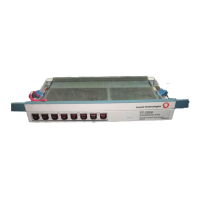Administration and Provisioning
Issue 8.0 July 2002
8-111
— The Start Daylight Savings Date parameter sets the date when the
network element moves the current time forward by 1 hour. It should
be entered in the form MM-DD where:
If this value is different from the Stop Daylight Savings Date
parameter value, daylight savings time is enabled and the time
change will occur at 02:00:00 on the chosen date. If the two values
are the same, daylight savings time processing is disabled. The
value 2-29 is not allowed.
— The Stop Daylight Savings Date parameter sets the date when the
network element moves the current time backward by 1 hour. It
should be entered in the form MM-DD where:
If this value is different from the Start Daylight Savings Date
parameter value, daylight savings time is enabled and the time
change will occur at 02:00:00 on the chosen date. If the two values
are the same, daylight savings time processing is disabled. The
value 2-29 is not allowed.
— The Daylight Savings Time Zone parameter is the 3-letter character
string (for example, EST, MST) that is printed as part of the date and
time stamp in command responses when Daylight Savings Time is
in effect.
■ CONFIGURATION-Set-EC1 (TL1 = ATTR-rr): This input sets the Alarm
Level and Signal Degrade Threshold of the EC-1 interface ports for signals
incoming from cross-connect panel. These parameters can be provisioned
when the selected low-speed interface slot(s) is unequipped or equipped
with any low-speed interface circuit pack. Thus, it is permissible to
pre-provision low-speed interface slots for EC-1 interfaces.
— The Alarm Level
*
parameter sets the severity of an incoming (from
the cross-connect panel) signal failure condition. The choices are:
- "CR": critical
-"MJ":major
- "MN": minor
- "NA": status not alarmed
- MM is the month (1-12)
- DD is the Day (1-31).
- MM is the month (1-12)
- DD is the Day (1-31).
* If the EC-1 port is part of a 1-way-DRI cross-connection, the alarm level should be
provisioned minor (MN).

